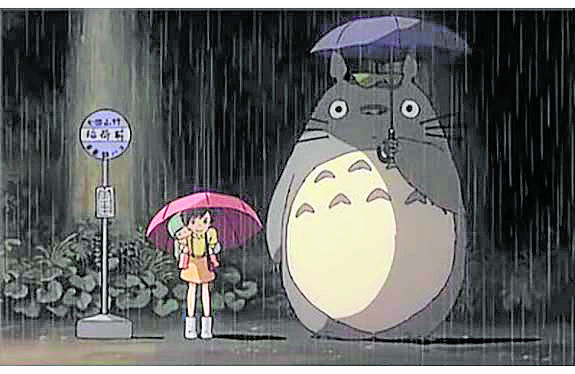In a time full of uncertainty and doubt, it’s beneficial to step back to view things from the perspective of a child—viewing the world with wide, bright eyes, taking everything without an ounce of intellectual application.
Hayao Miyazaki’s 1988 animated film “My Neighbor Totoro” revolves around the Kusakabe family as they settle into their new home in the countryside.
While exploring their new house, sisters Satsuki and Mei discover some friendly spirits in the forest behind their house, including the titular character, Totoro. The plot follows the daily lives of the family as they await the recovery of their mother in a local hospital, as well as the girls’ encounters with Totoro.
Similar to several of Miyazaki’s other works, the film doesn’t develop in a way where we anxiously await for the characters to tackle stressful conflict if there is any at all.
The Kusakabes live their everyday lives at a relaxed pace as they slowly adjust to the new area that they relocated to. Though Satsuki and Mei are fully aware and understanding of their mother’s health condition, it doesn’t dishearten nor hinder them from enjoying their daily activities. If anything, they’re able to find fun in the most mundane.
Miyazaki has mastered the skill of turning seemingly boring tasks into beautifully vibrant scenery that viewers can romanticize. Satsuki and Mei serve as perfect mediums in delivering this message. Despite their youth, they exhibit rather mature and independent personalities, similar to real Japanese children. But their youth also opens their eyes to a world full of innocent wonder, how most children see the world.
Smiles and giggles
Whether it be cleaning a dusty, old house, preparing lunch boxes or even just running around the yard, Satsuki and Mei live these only with smiles and giggles, genuinely enjoying the experience at hand.
When the younger sister encounters Totoro for the first time, a massive creature she’s never even heard of before, she doesn’t show the slightest bit of fear and even challenges it to a shouting contest. Mei is simply intrigued by this new neighbor she’s chanced upon.
Satsuki captures the essence of being an older sister to Mei, while still holding onto her own childlike personality. We see this as she carries the sleepy Mei outside in the rain, as they wait for their father’s bus to arrive, and she soon dances and laughs when she finally encounters Totoro that same night.
Nowadays, it’s so easy to be swept away by all the worries that circulate online. We’re living in a pandemic with no definite vaccine. If this film has any parting message, it’s that we have the power to see the world the way we want to.
Miyazaki captures how a child-like viewpoint of the world can make all the difference, especially in time of anxiety. Sure, life isn’t always positive, let alone romantic nor perfect. But we have the choice of how we view it.
When it’s all panic and pandemonium, this film serves as a reminder that there’s probably fun in even the most insignificant moments of life—that perhaps, a hole in the bucket could be fun, if only you allow it to be. —CONTRIBUTED INQ
The author is an AB Sociology freshman at the Ateneo de Manila University.